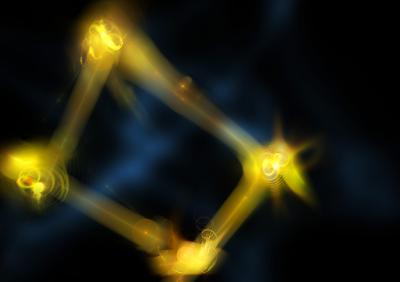Researchers of the team of Professor Anton Zeilinger at the Vienna Center for Quantum Science and Technology and the University of Vienna’s Institute for Quantum Optics and Quantum Information have experimentally demonstrated for the first time that it is possible to know whether two particles were in a separable or in an entangled quantum state even after their measurement or if they no longer exist.
 This abstract illustration shows four particles of light can be produced and manipulated in such a way that one can later decide in which quantum state two of the particles have been. (Credit: Jon Heras, Equinox Graphics)
This abstract illustration shows four particles of light can be produced and manipulated in such a way that one can later decide in which quantum state two of the particles have been. (Credit: Jon Heras, Equinox Graphics)
The study findings will be reported in the journal, Nature Physics. As per Erwin Schrödinger, an Austrian physicist, entanglement is the typical feature of mechanics. Besides playing an important role for the fundamentals of physics, entanglement is a major resource for future quantum information technologies, including quantum computation and quantum cryptography.
Entangled particles demonstrate more powerful and complex correlations when compared to those permitted by the classical physics laws. Two quantum-entangled particles demonstrate well-defined joint properties but they lose their individual properties. The researchers experimentally demonstrated a ‘Gedankenexperiment’ known as ‘delayed-choice entanglement swapping’ devised by Asher Peres.
Two sets of entangled photons were generated. A party named Victor received one photon from each set. Then, the party Alice received one of the two remaining photons, and the party Bob received the second. Now, Victor has two measurement options. If he considers the entangled state for his two photons, then the photon pair of Bob and Alice becomes entangled. If he selects a separable state for his pair of photons, the same state occurs in the photon pair of Bob and Alice.
Modern quantum optics technology enabled the researchers to impede the selection and measurement of Victor regarding the measurements performed by Bob and Alice on their photons. Xiao-song Ma, one of the researchers, explained that the research team was able to decide whether Bob's and Alice's photons are separable and demonstrate classical correlations or are entangled and demonstrate quantum correlations after the measurement of these photons.